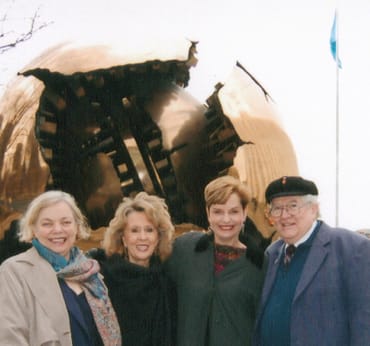Why NIGH?

Across her 40-year career, Florence Nightingale worked — beyond the role she called ‘Sick-nursing' — to also achieve a global advocacy role she called ‘Health-nursing.’ To accomplish this, she pro-actively and publicly championed for changes needed to improve health across the world.
What if today’s nurses and concerned citizens could be become — like Nightingale — public champions for the broader health of humanity?
This is a role yet to be fully realized — a role as change-agent beyond the hospital and clinic — to make our difference at global levels. But, how would we do this? The Nightingale Initiative for Global Health — often called NIGH — was created to explore this question.
The above photo, from NIGH's 2007 archives, commemorates the first time NIGH's founding team explored this question by meeting at the United Nations Headquarters in New York City. From left: Dr. Deva Marie Beck, Dr. Barbara Dossey & Dr. Cynda Rushton — who have served as International Co-Directors of NIGH — and Wayne Kines who serves as NIGH's Director of Global Communications.
As nurses and midwives, we know how to practice in hospitals and in clinic and community settings. We know our tasks and our tools.
We are often asked, “but, how to we practice global nursing?” At the global level, we do not have a syringe to deliver medicine to the broad scope of humanity. Nor do have we identified the protocols to determine our set of global tasks. What do we do?
NIGH’s answer has been to more clearly define how global health is actually achieved.
Global health is accomplished through communications at global levels. It is a worldwide advocacy about and for the health needs of humanity — the sharing of concern for problems that still need to be solved and appreciation for solutions achieved.
What are the tasks and tools of global nursing and midwifery?
We are already accomplished advocates. The task of global advocacy can simply become a widening of our scopes — to share the value of our perspectives and the effectiveness of our practices with our wider world.
Our tools are all around us. In the 21st century, the sharing of information is making a significant impact on the culture of humanity. Nurses and midwives can explore how to more-fully participate in this emerging culture. Our new global tools and tasks can include communications channels such as websites, radio talk-shows, letters to the editor, newspaper human interest stories, as well as through social media like YouTube.
Through these ‘media’ settings, we can be encouraged to become media-based health promotion advocates — to create, produce and air our ideas for the value of health in our communities and across our world.
We have always shared a vision — with each other — for healing and for health. Now, we can also share this vision with everyone else.
What if today’s nurses and concerned citizens could be become — like Nightingale — public champions for the broader health of humanity?
This is a role yet to be fully realized — a role as change-agent beyond the hospital and clinic — to make our difference at global levels. But, how would we do this? The Nightingale Initiative for Global Health — often called NIGH — was created to explore this question.
The above photo, from NIGH's 2007 archives, commemorates the first time NIGH's founding team explored this question by meeting at the United Nations Headquarters in New York City. From left: Dr. Deva Marie Beck, Dr. Barbara Dossey & Dr. Cynda Rushton — who have served as International Co-Directors of NIGH — and Wayne Kines who serves as NIGH's Director of Global Communications.
As nurses and midwives, we know how to practice in hospitals and in clinic and community settings. We know our tasks and our tools.
We are often asked, “but, how to we practice global nursing?” At the global level, we do not have a syringe to deliver medicine to the broad scope of humanity. Nor do have we identified the protocols to determine our set of global tasks. What do we do?
NIGH’s answer has been to more clearly define how global health is actually achieved.
Global health is accomplished through communications at global levels. It is a worldwide advocacy about and for the health needs of humanity — the sharing of concern for problems that still need to be solved and appreciation for solutions achieved.
What are the tasks and tools of global nursing and midwifery?
We are already accomplished advocates. The task of global advocacy can simply become a widening of our scopes — to share the value of our perspectives and the effectiveness of our practices with our wider world.
Our tools are all around us. In the 21st century, the sharing of information is making a significant impact on the culture of humanity. Nurses and midwives can explore how to more-fully participate in this emerging culture. Our new global tools and tasks can include communications channels such as websites, radio talk-shows, letters to the editor, newspaper human interest stories, as well as through social media like YouTube.
Through these ‘media’ settings, we can be encouraged to become media-based health promotion advocates — to create, produce and air our ideas for the value of health in our communities and across our world.
We have always shared a vision — with each other — for healing and for health. Now, we can also share this vision with everyone else.
|
|
This NIGH-produced video — 'Mobilizing Our Stories!' — was featured online for a Global Challenges Grant submission in 2013. It highlights NIGH's Daring, Caring & Sharing Campaign to Save Mother's Lives and anticipates NIGH's emerging plan to prepare nurses and midwives for new roles as 'citizen journalists and broadcasters' who share their stories of global health needs at local levels. |